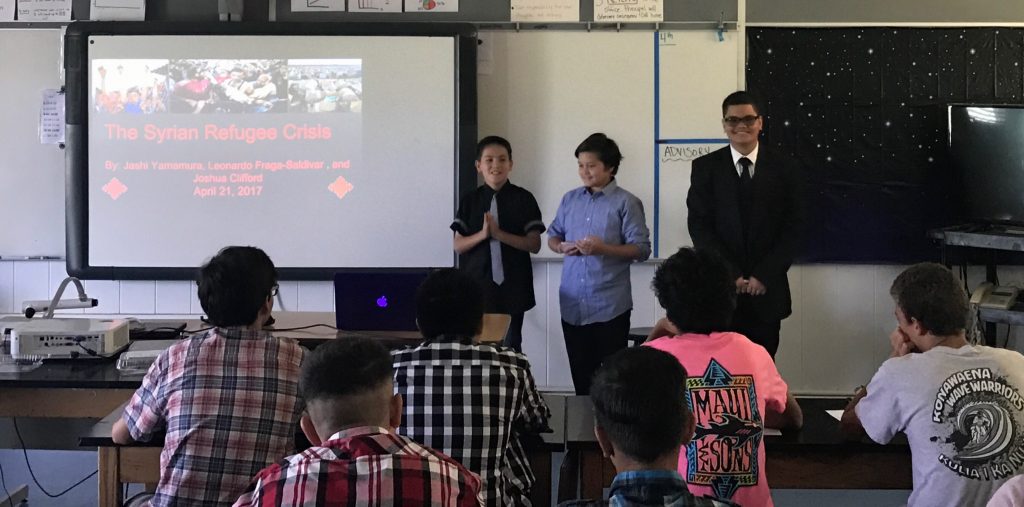Konawaena Students Tackle Local, National & Worldwide Problems
The energy at Konawaena Middle School in Kealakekua was exhilarating due to an exciting annual event.
It was a special day at KMS—even the students, who typically wear uniforms, were allowed to dress in their own attire. One group of students even created their own shirts just for the occasion.
Each school year, groups of eighth-grade students at KMS must tackle any preexisting anxieties they may have about standing in front of their peers and community members in order to present their Kūlia I Ka Nuʻu group projects.
Kūlia I Ka Nuʻu projects offer the opportunity for students to think critically about problems that are pertinent to both their immediate and remote worlds and asks them to come up with solutions to those problems.
The experience is meant to help them transition into high school and can certainly be beneficial in college and post-college.
These projects consist of identifying local, national and worldwide problems. Then they are required to conduct research, create a solution and write a 10-page paper.
The issues they chose to confront weren’t typical eighth-grade problems. Topics did not include how to get virtual “likes” on Facebook or even how to get real likes from a girlfriend or boyfriend.
The challenges they tackled were very much the opposite—deep and profound—including ocean pollution, endangered Hawaiian animals, teen depression, the Syrian refugee crisis, protecting Hawaiian culture, mālama ʻāina, drug overdosing and overfishing.
Possible solutions are not just theoretical—some students are attempting to apply their projects to real-life scenarios.
One group who researched “Preserving Native Hawaiian Forests,” looked for ways they could do good in their own backyards. They brought in keiki trees and will soon be planting them with their classmates.
Another group felt there was a lack of sports field infrastructure in Kona and wanted to do something about it.
“[The group] interviewed the director of Parks and Recreation in Hilo, Charmaine L. Kamaka… and asked her why Hilo has more sports fields than Kona,” said Rhianna Clark, an eighth-grade English teacher and a Kūlia I Ka Nuʻu’s organizer.
Director Kamaka informed them that there are plans to build a large sports complex in the Kealakehe area, but in order to not lose the gifted land, the county will need to start construction soon.
Clark said the group passed around letters of support for students to sign.
“They are going to send them to the mayor’s office this week in hope to continue the momentum and have the field built,” said Clark.
Another group focused inward, learning about their own history. Their project was about the United States’ nuclear bomb testing in the Marshall Islands. The testing included dropping a hydrogen bomb on Bikini Atoll in 1954, which contaminated the surrounding islands and people with high levels of radiation. The test was considered to be about 1,000 times more powerful than the atomic bomb dropped on Hiroshima. Their research revealed why a huge population of Marshallese people was relocated to Hawaiʻi.

Eighth graders tackle the Syrian refugee crisis as the topic of their Konawaena Middle School 2017 Kūlia I Ka Nuʻu project. Photo: Rhianna Clark

Eighth graders tackle tough topics during their Konawaena Middle School 2017 Kūlia I Ka Nuʻu project. Photo: Rhianna Clark

Eighth graders tackle tough topics during their Konawaena Middle School 2017 Kūlia I Ka Nuʻu project. Photo: Rhianna Clark

Eighth graders tackle tough topics during their Konawaena Middle School 2017 Kūlia I Ka Nuʻu project. Photo: Rhianna Clark
“Kūlia i ka nuʻu,” Queen Kapiʻolani’s motto meaning “strive to reach the summit” is exactly what KMS students accomplished during this significant challenge.

















